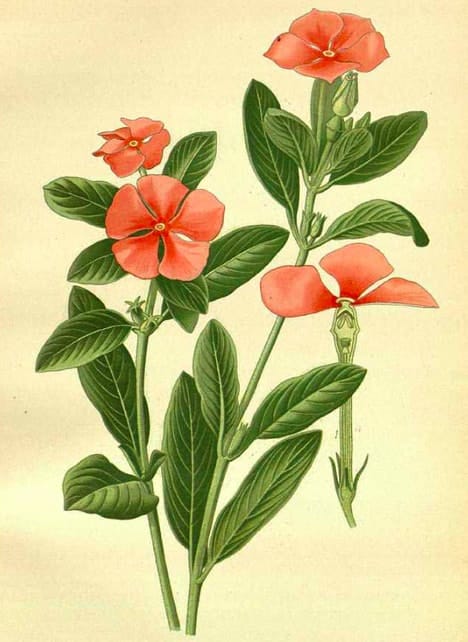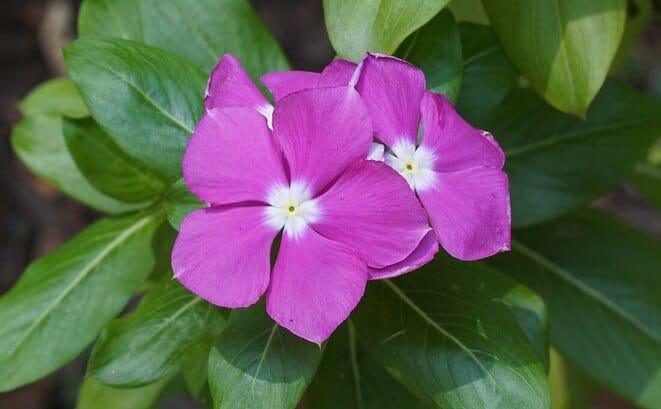Catharanthus, Madagascar PeriwinkleMadagascar Periwinkle, Rosey Periwinkle, Rose PeriwinkleSadapushpa, Nayantara (Ayurveda) Nithiya kalyani , Sudukadu mallikai (Siddha) Sadabahar (Unani) Chang Chun Hua (TCM) |

|

|
 Catharanthus roseus
Catharanthus roseusStep, E., Bois, D., Favourite flowers of garden and greenhouse (1896)
 Catharanthus roseus
Catharanthus roseus(Photo by Vengolis) (Wikimedia)
Botanical name:
Catharanthus roseus (syn. Vinca rosea, Lochera rosea, Ammocallis rosea)
Parts used:
Herb; sometimes the root
Temperature & Taste:
Cold, dry. Bitter. Toxic
Constituents:
Indole Alkaloids: over 100 alkaloids (0.86% in the root, 0.67% in the leaf); vinblastine (0.78-1.22% in the root; 4.5-9.00% in the root bark) and vincristine (0.00025%) are especially potent anti-cancer medicines
Triterpenoids, Sesquiterpenoids, Monoterpenoids, Benzenoids, Flavonoids
Uses:
1. Clears Heat, Moves the Blood, Resolves Masses:
-various cancers: Bladder, Breast, Testicular, Liver, Non-small cell Lung Cancer, Lymphosarcoma
-Lymphoma, Hodgkin’s Lymphoma; very effective in Acute Leukemia in children and Lymphocytic Leukemias
–Lymphosarcoma, Choriocarcinoma, Neuroblastoma
-crude extracts showed significant effect against various cancer cell lines.
-strong effect against Multi-drug Resistant cancers
-anti-angiogenic effect
2. Clears Heat, Nourishes Blood
-Thrombocytopenic Purpurea, Hemolytic Anaemia
3. Moves the Blood, Promotes Menstruation:
-Amneorrhea, Dysmenorrhea
-cleanses and restores Uterus after childbirth
-also for Menopause and Menorrhagia (Duke)
4. Clears Heat, Resists Poison, Calms the Liver:
-Fever, Cold, Flu, Malaria
-acute Sore Throat, Cough
-Abscess, Boil, Toxic Sores, Ulcers, Dermatitis (topically and internally)
-Dysentery, Enteritis
-leaf extract is effective against streptococcal and staphylococcal infections
-Gonorrhea
-Hypertension
-Red, Sore Eyes (also as an eyewash)
-Insect bites (topically)
5. Clears Heat, Benefits the Kidneys:
-Oliguria, Hematuria
-effective against Diabetes
-Root has been used for Lumbago
Dose:
Powder of the Herb: 2–3 grams (up to 10 grams); 10 grams of leaf powder (daily), taken with hot water for Cancer and Leukemia although this dose should be gradually built up to..
Of the Flower: 5 grams twice daily for Diabetes; 9 flowers decocted in 1 pint of water for Colds and Sore Throat.
Infusion: 9 flowers added to 1 pint water and steeped in the sun for 3 hours. (Duke)
Decoction of the Herb: 4–8 grams; 30 grams is reportedly decocted in Malaysia (Medicinal plants of Southeast Asia. Malaysia, Wiart, 2000)
A decoction (1 in 8) can be taken in doses of 300–450mls.
Alternatively, 10 leaves and 10 flowers, decocted briefly. (Duke)
Some sources have recommended one fresh leaf, twice daily. (Indusyunic)
Expressed juice mixed with equal parts of Honey: 20–40mls
Crushed leaves can be applied topically to Sores and Ulcers.
Comment:
Vincristine and Vinblastine are used intravenously in modern medicine to treat Hodgkin’s Disease and pediatric Leukemias respectively.
Correctives:
Armenian (Red) Earth (Unani)
Substitute:
1. Periwinkle
2. Cotton root
3. Gelsemium (Unani)
4. Catharanthus roseus is regarded as a substitute for Rhazya stricta in Unani. (Indusyunic)
Main Combinations:
1. Cancer:
i. Catharanthus with Scutellaria Ban Zhi Lian, Oldenlandia Bai Hua She She Cao, Astragalus Huang Qi
ii. Potent Anti-Tumor and Anti-Angiogenic effect, Catharanthus with Barberry bark, Figwort (Xuan Shen), Coptis Huang Lian
iii. Lymphatic Cancer, Catharanthus with Self Heal (Xia Ku Cao), Figwort (Xuan Shen)
iv. Lung Cancer, Catharanthus with Black Nightshade, Houttuynia Yu Xing Cao, Bitter Almond (Ku Xing Ren)
v. Lung Cancer, Catharanthus with Plantain leaf, Comfrey, Licorice
vi. Breast Cancer, Catharanthus with Black Nightshade, Asparagus root (Tian Men Dong), Self Heal (Xia Ku Cao), Ctrus Qing Pi
vii. Liver Cancer, Catharanthus with Black Nighshade, Rhubarb, Wormwood
2. Diabetes: Catharanthus with Gymnema
3. Itching of the Skin, a paste of the leaves with Henna is applied (Unani)
Major Formulas:
Cautions:
1. Avoid overdose. Overdose causes severe leukopenia.
2. Not used in Pregnancy
3. Avoid use or use very cautiously in those with Liver disease; SGOT and SGPT levels can increase significantly with oral administration.
4. Burning skin has been reported as an adverse reaction to internal administration.
Toxicity:
1. Indole alkaloids of Catharanthus induce granulocytopenia and bone marrow depression.
2. Ethanol Extract had no toxic effects on Liver or Kidney at a dose of 200mg/kg in animals.
3. Methanol extract in doses of 0.1 to 1 g/kg to rats didn’t cause mortality.
4. Evaluation of Acute Oral Toxicity of Ethanol Leaves Extract of Catharanthus roseus in Wistar Albino Rats
Main Preparations used:
-
Extra Info
- Research
